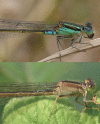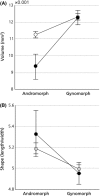Alternative trait combinations and secondary resource partitioning in sexually selected color polymorphism
- PMID: 23919150
- PMCID: PMC3728945
- DOI: 10.1002/ece3.610
Alternative trait combinations and secondary resource partitioning in sexually selected color polymorphism
Abstract
Resource partitioning within a species, trophic polymorphism is hypothesized to evolve by disruptive selection when intraspecific competition for certain resources is severe. However, in this study, we reported the secondary partitioning of oviposition resources without resource competition in the damselfly Ischnura senegalensis. In this species, females show color polymorphism that has been evolved as counteradaptation against sexual conflict. One of the female morphs is a blue-green (andromorph, male-like morph), whereas the other morph is brown (gynomorph). These female morphs showed alternative preferences for oviposition resources (plant tissues); andromorphs used fresh (greenish) plant tissues, whereas gynomorphs used decaying (brownish) plants tissues, suggesting that they chose oviposition resources on which they are more cryptic. In addition, the two-color morphs had different egg morphologies. Andromorphs have smaller and more elongated eggs, which seemed to adapt to hard substrates compared with those of gynomorphs. The resource partitioning in this species is achieved by morphological and behavioral differences between the color morphs that allow them to effectively exploit different resources. Resource partitioning in this system may be a by-product of phenotypic integration with body color that has been sexually selected, suggesting an overlooked mechanism of the evolution of resource partitioning. Finally, we discuss the evolutionary and ecological consequences of such resource partitioning.
Keywords: Body color; camouflage; choice; damselfly; egg morphology; female polymorphism; oviposition; phenotypic integration; resource partitioning.
Figures





Similar articles
-
Candidate genes associated with color morphs of female-limited polymorphisms of the damselfly Ischnura senegalensis.Heredity (Edinb). 2019 Jan;122(1):81-92. doi: 10.1038/s41437-018-0076-z. Epub 2018 May 1. Heredity (Edinb). 2019. PMID: 29713090 Free PMC article.
-
Morph-specific fecundity and egg size in the female-dimorphic damselfly Ischnura senegalensis.Zoolog Sci. 2010 Apr;27(4):325-9. doi: 10.2108/zsj.27.325. Zoolog Sci. 2010. PMID: 20377351
-
A geographic cline induced by negative frequency-dependent selection.BMC Evol Biol. 2011 Sep 14;11:256. doi: 10.1186/1471-2148-11-256. BMC Evol Biol. 2011. PMID: 21917171 Free PMC article.
-
Spectral sensitivities and color signals in a polymorphic damselfly.PLoS One. 2014 Jan 31;9(1):e87972. doi: 10.1371/journal.pone.0087972. eCollection 2014. PLoS One. 2014. PMID: 24498233 Free PMC article.
-
Linking Molecular Mechanisms and Evolutionary Consequences of Resource Polyphenism.Front Integr Neurosci. 2022 Feb 8;16:805061. doi: 10.3389/fnint.2022.805061. eCollection 2022. Front Integr Neurosci. 2022. PMID: 35210995 Free PMC article. Review.
Cited by
-
Candidate genes associated with color morphs of female-limited polymorphisms of the damselfly Ischnura senegalensis.Heredity (Edinb). 2019 Jan;122(1):81-92. doi: 10.1038/s41437-018-0076-z. Epub 2018 May 1. Heredity (Edinb). 2019. PMID: 29713090 Free PMC article.
-
Local Adaptation of Bacterial Symbionts within a Geographic Mosaic of Antibiotic Coevolution.Appl Environ Microbiol. 2019 Nov 27;85(24):e01580-19. doi: 10.1128/AEM.01580-19. Print 2019 Dec 15. Appl Environ Microbiol. 2019. PMID: 31676475 Free PMC article.
References
-
- Abbott JK. Morph-specific and sex-specific temperature effects on morphology in the colour polymorphic damselfly Ischnura elegans. Anim. Biol. 2013;63:149–167.
-
- Abbott JK, Gosden TP. Correlated morphological and colour differences among females of the damselfly Ischnura elegans. Ecol. Entomol. 2009;34:378–386.
-
- Abbott J, Svensson EI. Phenotypic and genetic variation in emergence and development time of a trimorphic damselfly. J. Evol. Biol. 2005;18:1464–1470. - PubMed
-
- Abbott JK, Svensson EI. Morph-specific variation in intersexual genetic correlations in an intra-specific mimicry system. Evol. Ecol. Res. 2010;12:105–118.
-
- Ahnesjö J, Forsman A. Correlated evolution of colour pattern and body size in polymorphic pygmy grasshoppers, Tetrix undulata. J. Evol. Biol. 2003;16:1308–1318. - PubMed
LinkOut - more resources
Full Text Sources
Other Literature Sources

